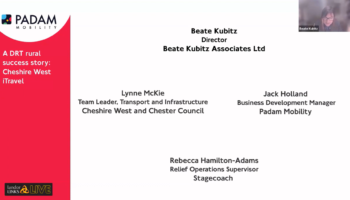The efficiency and success of a Demand-Responsive Transport (DRT) service is based on several steps. In this article, we will discuss the first two essential steps for an effective DRT: the feasibility study and its simulations, and then the pilot.
What is a dynamic Demand-Responsive Transport?
The aim of a dynamic DRT is to rationalise public transport by fine-tuning supply to demand with more interesting economic and ecological benefits. Vehicles, reserved via a mobile application, a website or a call centre, replace under-used or non-existent fixed lines. Their route is optimised thanks to algorithms.
Step 1: the feasibility study and the simulations
The goal of the feasibility study is to understand the operation and use of DRT on a territory and to question its rationality from an economic point of view. It is used to define supply and demand scenarios, obtain reliable performance indicators, and understand how these evolve according to the different scenarios defined.
The simulations, preferably taken from the DRT platform, make it possible to put figures on the different scenarios based on reservation data, demographic data, transport surveys or telephone data, making it possible to anonymously track journeys within a territory. The simulations operate in-vivo and also make it possible to validate the economic relevance of the service, to ensure the correct configuration of the offer and to identify the risks.
What indicators should be taken into account at this stage?
- Quality of service: waiting time, percentage of requests served and average detour rate: how do users feel about the quality of service? Are they satisfied enough to re-use the service on a regular basis?
- Cost of service: number of people per hour per vehicle per trip, mileage, number of vehicles used and maximum vehicle occupancy rate.
What questions should be asked before moving on to the next step?
- Is the service financially sustainable and acceptable to the community?
- Is the project politically tenable?
- Will users and operational teams agree to host an innovative project such as DRT?
Read more about the feasibility study and simulations carried out for Aviapolis (Helsinki, Finland) by Padam Mobility
Step 2: the pilot
The pilot, whose watchword is agility, is used to test, measure and iterate over short cycles. The pilot is used to validate the relevance of the new DRT service for the need for mobility, the digital transition to a SaaS tool and the strategies and means of communication with the population. It also makes it possible to test the uses of DRT and to understand the issues involved (traction, quality of service, operational handling, etc.).
What indicators should be taken into account at this stage?
- Quantitative data: number of visitors, distribution of the reservation application & website VS call centre, number of passengers per vehicle and per commercial trip, quality of service.
- Qualitative data: human transition and change management, satisfaction surveys.
- Network balance: frequentation of non DRT lines that pass nearby.
What questions should be asked before moving on to the next stage?
- What is the trend? Is it stable?
- How is the economic balance of the service?
- What is the capacity to replicate the service operationally in other areas, possibly with different operations or uses?
Learn more about the pilot carried out for Keolis in Orleans by Padam Mobility





